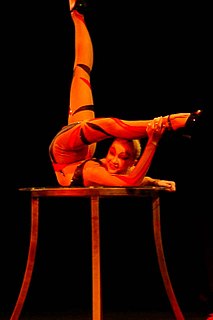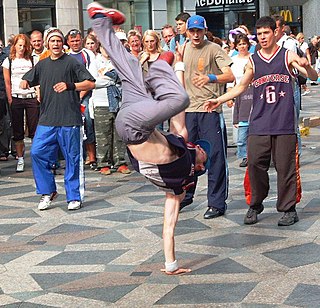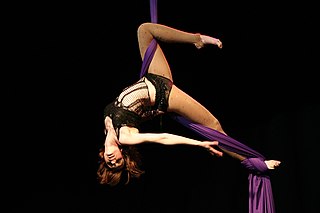
Contortion is a performance art in which performers called contortionists showcase their skills of extreme physical flexibility. Contortion acts often accompany acrobatics, circus acts, street performers and other live performing arts. Contortion acts are typically performed in front of a live audience. An act will showcase one or more artists performing a choreographed set of moves or poses, often to music, which require extreme flexibility. The physical flexibility required to perform such acts greatly exceeds that of the general population. It is the dramatic feats of seemingly inhuman flexibility that captivate audiences.

A trapeze is a short horizontal bar hung by ropes or metal straps from a support. It is an aerial apparatus commonly found in circus performances. Trapeze acts may be static, spinning, swinging or flying, and may be performed solo, double, triple or as a group act.
The Spanish web is an aerial circus skill in which a performer climbs and performs various tricks on an apparatus resembling a vertically hanging rope. It is similar in appearance and performance style to the corde lisse, but with the addition of loops on the rope for hands or feet, permitting one to perform a variety of spinning motions. The name refers to both the apparatus and the performance.
Attacking maneuvers are offensive moves in professional wrestling, used to set up an opponent for a submission hold or for a throw. There are a wide variety of attacking moves in pro wrestling, and many are known by several different names. Professional wrestlers frequently give their finishers new names. Occasionally, these names become popular and are used regardless of the wrestler performing the technique.
Saltimbanco was a touring show by Cirque du Soleil. Saltimbanco ran from 1992 to 2006 in its original form, performed under a large circus tent called the Grand Chapiteau; its last performance in that form was in Rio de Janeiro, Brazil, on December 10, 2006. A new adaptation of the show started touring North America on July 31, 2007, with its first stop in London, Ontario, Canada. The new version was staged in arenas with fewer performances in each city it visited. The new version closed at the end of 2012.

A handspring is an acrobatic move in which a person executes a complete revolution of the body by lunging headfirst from an upright position into an inverted vertical position and then pushing off from the floor with the hands so as to leap back to an upright position. The direction of body rotation in a handspring may be either forward or backward, and either kind may be performed from a stationary standing position or while in motion. Body movement may be terminated upon completion of a handspring, or the performer's momentum may be leveraged so as to immediately perform another handspring or other rotational move.

The Russian bar is a circus act which combines the gymnastic skills of the balance beam, the rebound tempo skills of trampoline, and the swing handstand skills of the uneven bars and the parallel bars. The bar itself is a flexible vaulting pole around 4 meters long, typically made of fibreglass. This genre of circus act was first created by the Russian artist Alexander Moiseev, who brought his act twice to the International Circus Festival of Monte-Carlo, winning the Gold and Silver Clown.

The kettlebell is a cast iron or cast steel ball with a handle attached to the top. It is used to perform many types of exercises, including ballistic exercises that combine cardiovascular, strength and flexibility training. They are also the primary equipment used in the weight lifting sport of kettlebell lifting.

The flying trapeze is a specific form of the trapeze in which a performer jumps from a platform with the trapeze so that gravity makes the trapeze swing.

The flare is an acrobatic move in which the performer alternates balancing the torso between either arm while swinging the legs beneath in continuous circles. It is a fundamental b-boying power move, and in gymnastics it may be performed on a pommel horse or during the floor exercise. The move is commonly spelled flair in gymnastics and further may be called a "Thomas flair" after its originator, Kurt Thomas.

A freeze is a b-boying technique that involves halting all body motion, often in an interesting or balance-intensive position. It is implied that the position is hit and held from motion as if freezing in motion, or into ice. Freezes often incorporate various twists and distortions of the body into stylish and often difficult positions.

Aerial silks is a type of performance in which one or more artists perform aerial acrobatics while hanging from a fabric. The fabric may be hung as two pieces, or a single piece, folded to make a loop, classified as hammock silks. Performers climb the suspended fabric without the use of safety lines and rely only on their training and skill to ensure safety. They use the fabric to wrap, suspend, drop, swing, and spiral their bodies into and out of various positions. Aerial silks may be used to fly through the air, striking poses and figures while flying. Some performers use dried or spray rosin on their hands and feet to increase the friction and grip on the fabric.

Static trapeze, also known as fixed trapeze, is a type of circus art performed on the trapeze. In contrast to the other forms of trapeze, on static trapeze the bars and ropes mainly stay in place.
The cloud swing is an aerial act that usually combines static and swinging trapeze skills, drops, holds and rebound lifts.

Pole climbing is ascending a pole which one can grip with his or her hands. The related activity of mast climbing describes ascending an object similar to a pole, but having a larger diameter which excludes gripping with the hands. In either case, it is normally assumed that climbers who view the activity as a gymnastic sport use only their bodies and limbs, without artificial aids.
Mallakhamba/Mallakhamb is a traditional sport, originating from the Indian subcontinent, in which a gymnast performs aerial yoga postures and wrestling grips in concert with a vertical stationary or hanging wooden pole, cane, or hanging rope. The word Mallakhamb also refers to the pole used in the sport. The pole is usually made from Seesham polished with castor oil. Three popular versions of Mallakhamba are practiced using a sheesham pole, cane, or rope.

Totem is a touring show by Cirque du Soleil that premiered in Montréal on April 22, 2010. It was written and directed by previous collaborator Robert Lepage (Kà). Cirque du Soleil describes Totem's theme as the evolution of humanity from its primordial, amphibian state toward the aspiration of flight, taking inspiration from many of humanity's founding myths. The show was awarded the 2013 New York Drama Desk Award for Unique Theatrical Experience.

Slackwire is an acrobatic circus act that involves the balancing skills of moving along a flexible, thin wire suspended in the air, connected to two anchor points. Slackwire is not to be confused with slacklining.













